Study on Catastrophe Information Characteristics of Strain-Structural Plane Slip Rockburst in Deep Tunnels
Abstract
:1. Introduction
2. A Novel 3D Discrete Element Numerical Analysis Method for Rockburst
2.1. Shortcomings of Previous Rockburst Analysis Methods
2.2. Multi-Parameter Rockburst Proneness Index Based on Energy Theory
2.3. Rockburst Simulation Analysis Method Based on the Bonded Block Model and Energy Index
3. Numerical Model and Simulation Scheme of the Strain-Structural Plane Slip Rockburst
3.1. Numerical Model and Boundary Conditions
3.2. Constitutive Model and Material Mechanical Parameters
3.3. Numerical Simulation Scheme
4. Multivariate Catastrophe Information Characteristics of the Strain-Structural Plane Slip Rockburst under Different Conditions
4.1. Characteristics of Stress Information
4.2. Characteristics of Energy Information
4.3. Characteristics of Fracture Information
4.4. Characteristics of Rockburst Proneness
5. Case Study: “11.28” Rockburst in Jinping II Drainage Tunnel
5.1. Project Overview
5.2. Model Establishment and Mechanical Parameters
5.3. Simulation Results and Analysis
6. Conclusions
- (1)
- A rockburst numerical analysis method is proposed using the bonded block model and the multi-parameter rockburst energy index. This method improves the modeling speed and calculation accuracy. It can not only simulate the fracture initiation, propagation, and interaction between blocks but also consider the various stress states of the rock unit. It realizes the visual analysis of the multivariate information response of the surrounding rock, the rockburst intensity and occurrence range, and the real simulation of the structure plane control effect on rockburst under the three-dimensional stress state.
- (2)
- As the dip angle increases, the fracture propagation range of rock mass between the tunnel and structural plane generally shows an increasing trend, the fracture width increases, and the intensity level and occurrence range of rockburst gradually decrease. As the length increases, the fracture propagation range, rockburst intensity, and occurrence range of the rock mass increase slightly. As the relative distance increases, the fracture propagation range and rockburst intensity decrease, while the occurrence range of rockburst increases first and then decreases.
- (3)
- With the increase in the surrounding rock depth, the distribution of rockburst proneness index Crs value presents a tendency of first decreasing, then increasing, and finally decreasing. The rockburst proneness in the risk area is strong-weak-sub-strong-weak and then induces a rockburst. The increasing stage of rockburst intensity is distributed near the structural plane, and its distribution characteristics are basically consistent with the characteristics of stress and energy information. The order of influence degree for the structural plane on rockburst proneness is relative distance > dip angle > length.
- (4)
- The engineering verification study was conducted on the “11.28” rockburst case in the Jinping II drainage tunnel. The peak value of rockburst index Crs between the tunnel and structural plane is greater than 40, and the larger value is distributed in a “V” shape, which is consistent with the geometric distribution of the actual rockburst pit, and the structural plane controls the boundary of the rockburst pit. The numerical analysis method for rockburst proposed in this paper can better predict and reflect the catastrophic characteristics of the strain-structural plane slip rockburst, and the case study also has verified the rationality and applicability of the method.
Author Contributions
Funding
Institutional Review Board Statement
Informed Consent Statement
Data Availability Statement
Conflicts of Interest
References
- Park, C.H.; Bobert, A. Crack coalescence in specimens with open and closed flaws: A comparison. Int. J. Rock Mech. Min. 2009, 46, 819–829. [Google Scholar] [CrossRef]
- Li, J.C.; Ma, G.W.; Zhao, J. An equivalent viscoelastic model for rock mass with parallel joints. J. Geophys. Res. 2010, 115, B03305. [Google Scholar] [CrossRef]
- Su, F.S.; Pan, P.Z.; Gao, Y.H.; Feng, X.T.; Liu, C. Experimental study on failure process and mechanism of marble containing natural hard structural plane. Chin. J. Rock Mech. Eng. 2018, 37, 611–620. [Google Scholar]
- Guo, J.Q.; Cheng, L.P.; Zhu, B.Z.; Tian, Y.C.; Huang, X. Shear mechanical properties and energy characteristics of rock joints under continuous excavation effect. Rock Soil. Mech. 2023, 44, 131–143. [Google Scholar]
- He, M.C. Status Quo and Prospect of Rock Mechanics in Deep Mining Engineering. In Proceedings of the 8th National Congress on Rock Mechanics and Engineering, Beijing, China, 1 October 2004; pp. 99–105. [Google Scholar]
- Zhou, H.; Meng, F.Z.; Zhang, C.Q.; Hu, D.W.; Yang, F.J.; Lu, J.J. Analysis of rockburst mechanisms induced by structural planes in deep tunnels. Bull. Eng. Geol. Environ. 2015, 74, 1435–1451. [Google Scholar] [CrossRef]
- Wang, Y.C.; Tang, C.A.; Tang, L.X.; Zhang, S.C.; Li, L.M.; Li, Y.B.; Duan, W.S. Microseismicity Characteristics Before and After a Rockburst and Mechanisms of Intermittent Rockbursts in a Water Diversion Tunnel. Rock Mech. Rock Eng. 2022, 55, 341–361. [Google Scholar]
- Liu, F.; Tang, C.A.; Ma, T.H.; Tang, L.X. Characterizing Rockbursts Along a Structural Plane in a Tunnel of the Hanjiang-to-Weihe River Diversion Project by Microseismic Monitoring. Rock Mech. Rock Eng. 2019, 52, 1835–1856. [Google Scholar]
- Feng, X.T.; Xiao, Y.X.; Feng, G.L.; Yao, Z.B.; Chen, B.R.; Yang, C.X.; Su, G.S. Study on the development process of rockbursts. Chin. J. Rock Mech. Eng. 2019, 38, 649–673. [Google Scholar]
- Das, R.; Singh, T.N. A novel technique for temporal evolution of rockburst in underground rock tunnel: An experimental study. Environ. Earth Sci. 2022, 81, 420. [Google Scholar]
- Cheng, G.T.; Zhang, J.; Gao, Q.; Liu, C. Experimental Study on the Influence Mechanism of the Structural Plane to Rockbursts in Deeply Buried Hard Rock Tunnels. Shock. Vib. 2021, 2021, 9839986. [Google Scholar] [CrossRef]
- Gong, H.L.; Luo, Y.; Xu, K.; Wang, X.Y.; Tao, Y.H.; Li, X.P. Mechanical characteristics of failure and rockburst proneness of fractured granite from Shuangjiangkou hydropower station under triaxial loading and unloading. Bull. Eng. Geol. Environ. 2023, 82, 256. [Google Scholar] [CrossRef]
- Manouchehrian, A.; Cai, M. Numerical modeling of rockburst near fault zones in deep tunnels. Tunn. Undergr. Space Technol. 2018, 80, 164–180. [Google Scholar] [CrossRef]
- Feng, F.; Li, X.B.; Rostami, J.; Li, D.Y. Modeling hard rock failure induced by structural planes around deep circular tunnels. Eng. Fract. Mech. 2019, 205, 152–174. [Google Scholar] [CrossRef]
- Wang, P.; Yin, Z.Y.; Hicher, P.Y.; Cui, Y.J. Micro-mechanical analysis of one-dimensional compression of clay with DEM. Int. J. Numer. Anal. Met. 2023, 47, 2706–2724. [Google Scholar] [CrossRef]
- Yin, Z.Y.; Wang, P.; Zhang, F.S. Effect of particle shape on the progressive failure of shield tunnel face in granular soils by coupled FDM-DEM method. Tunn. Undergr. Space Technol. 2020, 100, 103394. [Google Scholar] [CrossRef]
- Zhou, X.; Meng, F.Z.; Yue, Z.F.; Wang, W.; Xu, R.C.; Zhou, H.; Guan, X.M. Evolution and mechanism of rockburst induced by structural plane based on GDEM. J. China Coal Soc. 2023, 48, 2207–2223. [Google Scholar]
- Zhao, C.; Bao, C.; Tian, J.S.; Matsuda, H.; Morita, C. Experimental study of coalescence mode of cracks and strength of rock with double flaws based on strain localization. Chin. J. Rock Mech. Eng. 2015, 34, 2309–2318. [Google Scholar]
- Zhang, C.Q.; Zhou, H.; Feng, X.T. An index for estimating the stability of brittle surrounding rock mass: FAI and its engineering application. Rock Mech. Rock Eng. 2011, 44, 401–414. [Google Scholar] [CrossRef]
- Su, G.S.; Feng, X.T.; Jiang, Q.; Chen, G.Q. Study on new index of local energy release rate for stability analysis and optimal design of underground rockmass engineering with high geostress. Chin. J. Rock Mech. Eng. 2006, 25, 2453–2460. [Google Scholar]
- Xie, H.P.; Ju, Y.; Li, L.Y. Criteria for strength and structural failure of rocks based on energy dissipation and energy release principles. Chin. J. Rock Mech. Eng. 2005, 17, 3003–3010. [Google Scholar]
- Zhu, B.Z.; Fan, J.Q.; Shi, X.Y.; Liu, P.F.; Guo, J.Q. Study on Rockburst Proneness of Deep Tunnel Under Different Geo-Stress Conditions Based on DEM. Geotech. Geol. Eng. 2022, 40, 1373–1386. [Google Scholar] [CrossRef]
- Zhang, H.Y.; Fan, J.Q.; Guo, J.Q.; Shi, X.Y.; Sun, F.Y. Rockburst Tendency for Deep Underground Engineering Based on Multi-Parameters Criterion. Chin. J. High. Press. Phys. 2022, 36, 176–189. [Google Scholar]
- Jiang, B.Y.; Ding, M.J.; Li, W.S.; Gu, S.T.; Ji, H.G. Investigation on Characteristics and Prevention of Rockburst in a Deep Hard and Soft Compound Stratum Tunnel Excavated Using TBM. Sustainability 2022, 14, 3190. [Google Scholar] [CrossRef]
- Cheng, Z.H.; Su, S.L.; Wang, X. Study on mining-induced fracture field of contiguous coal seam with BBM-DEM simulation. Coal Sci. Technol. 2019, 47, 1–9. [Google Scholar]
- Zhu, D.F.; Tu, S.H.; Ma, H.S.; Zhang, X.W. A 3D Voronoi and subdivision model for calibration of rock properties. Model. Simul. Mater. Sci. 2017, 25, 85005. [Google Scholar] [CrossRef]
- Yang, W. Study on Numerical Analysis Method of Hard Rock Failure Process and Mechanism; Chongqing University: Chongqing, China, 2021. [Google Scholar]
- Lavoie, T.; Eberhardt, E.; Pierce, M.E. Numerical modelling of rock mass bulking and geometric dilation using a bonded block modelling approach to assist in support design for deep mining pillars. Int. J. Rock Mech. Min. 2022, 156, 105145. [Google Scholar] [CrossRef]
- Gao, F.Q.; Kang, H.P.; Li, J.Z. Numerical simulation of fault-slip rockbursts using the distinct element method. Tunn. Undergr. Space Technol. 2021, 110, 103805. [Google Scholar] [CrossRef]
- Shi, C.; Chu, W.J.; Zheng, W.T. Block Discrete Element Numerical Simulation Technology and Engineering Application; Architecture and Building Press: Beijing, China, 2016. [Google Scholar]
- Fu, T.F.; Xu, T.; Zhu, W.C.; Wang, X.W. Damage characteristics of sandstone under triaxial compression based on polycrystalline discrete element method. J. Northeastern Univ. (Nat. Sci.) 2020, 41, 968–974. [Google Scholar]
- Guo, J.Q.; Zhang, H.Y.; Sun, F.Y.; Shi, X.Y.; Zhu, B.Z.; Guo, P. Numerical Simulation Study of Catastrophe Process for Structural–Slip Rockburst. Geotech. Geol. Eng. 2023, 41, 4007–4022. [Google Scholar] [CrossRef]
- Zhang, C.Q.; Feng, X.T.; Zhou, H.; Qiu, S.L.; Wu, W.P. Rockmass damage development following two extremely intense rockbursts in deep tunnels at Jinping II hydropower station, southwestern China. Bull. Eng. Geol. Environ. 2013, 72, 237–247. [Google Scholar] [CrossRef]
- Zhang, C.Q.; Feng, X.T.; Zhou, H.; Qiu, S.L.; Wu, W.P. Case Histories of Four Extremely Intense Rockbursts in Deep Tunnels. Rock Mech. Rock Eng. 2012, 45, 275–288. [Google Scholar] [CrossRef]
- Zhang, R.J.; Liu, Y.R.; Hou, S.K. Evaluation of rockburst risk in deep tunnels considering structural planes based on energy dissipation rate criterion and numerical simulation. Tunn. Undergr. Space Technol. 2023, 137, 105128. [Google Scholar] [CrossRef]
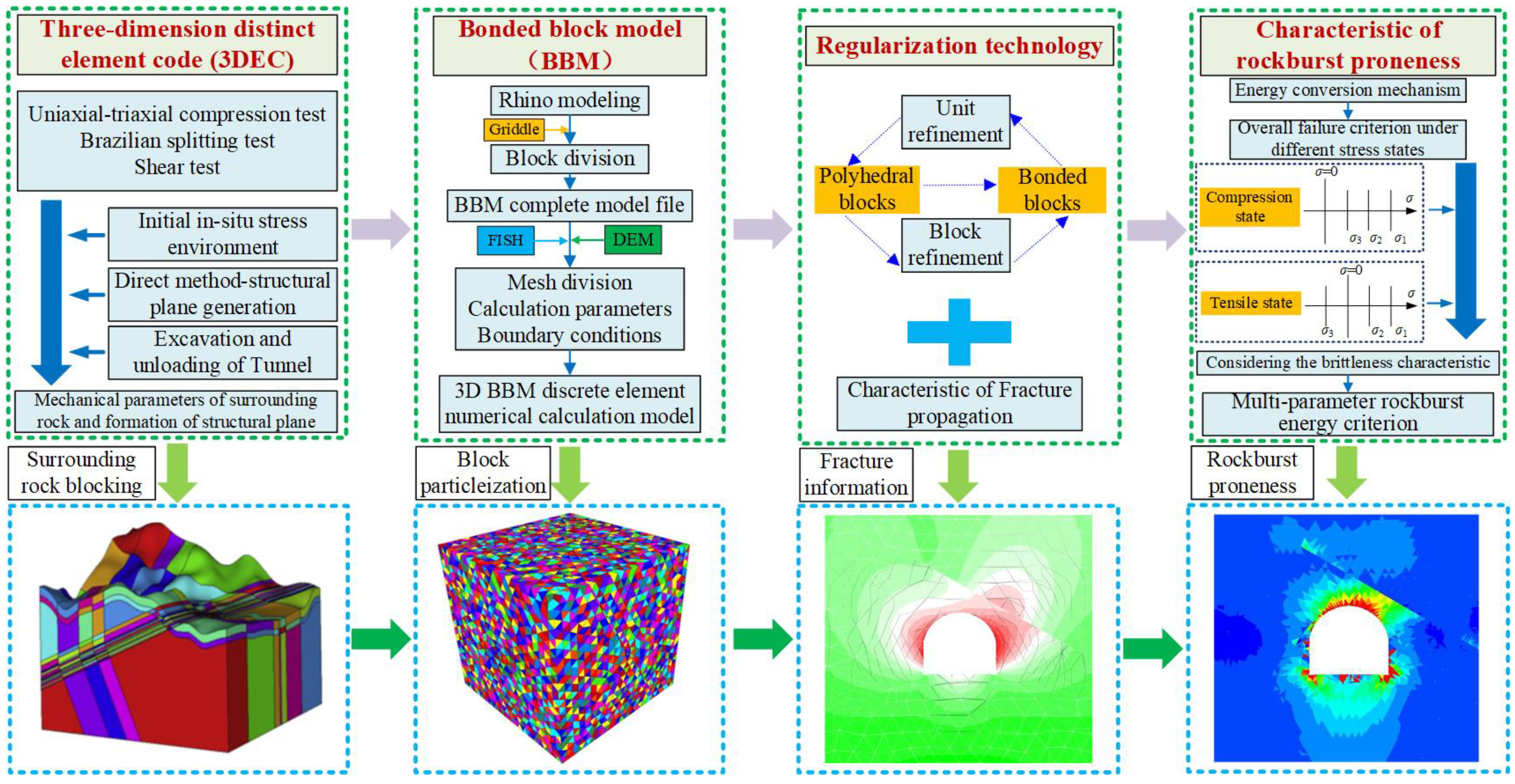
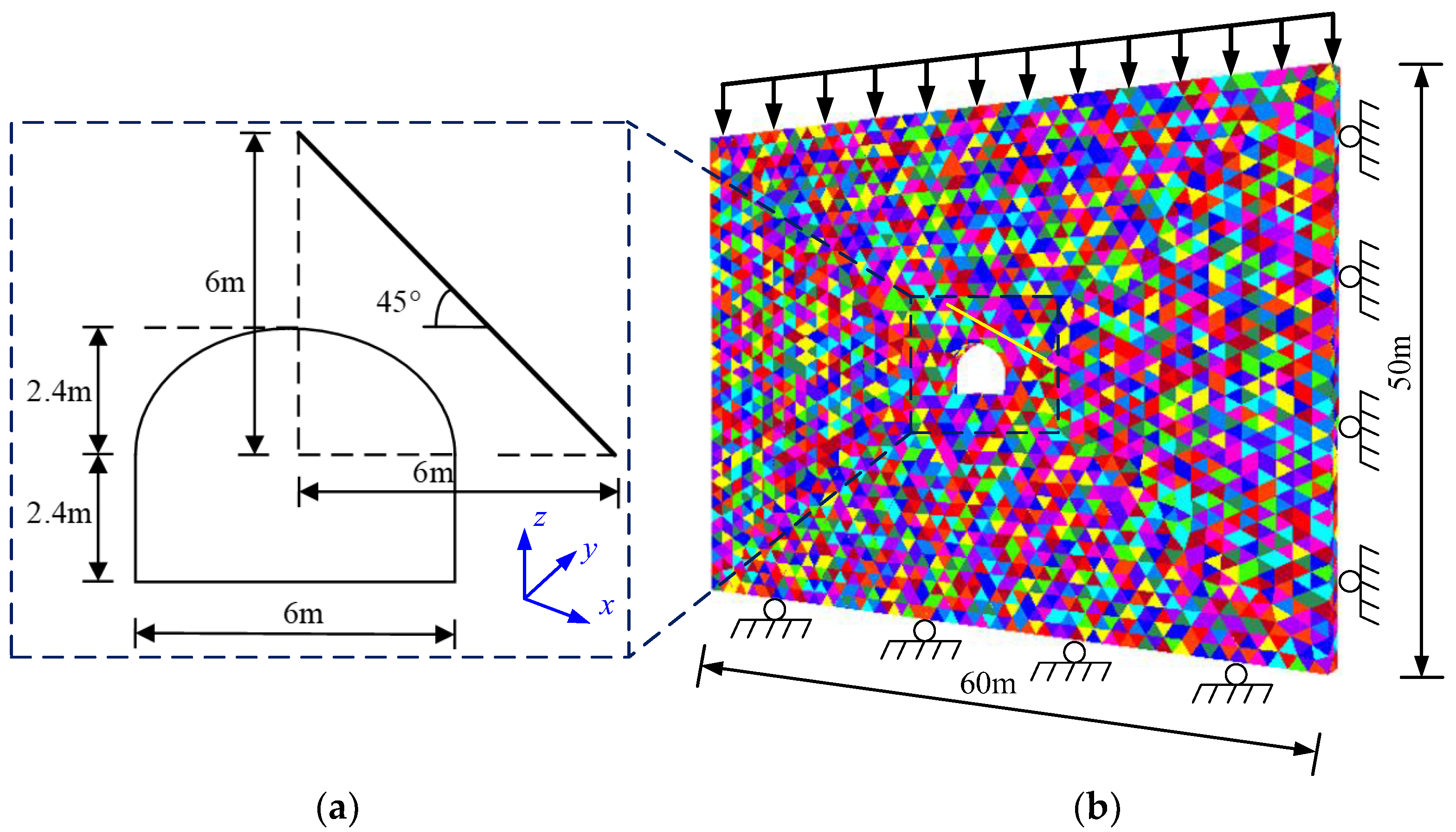

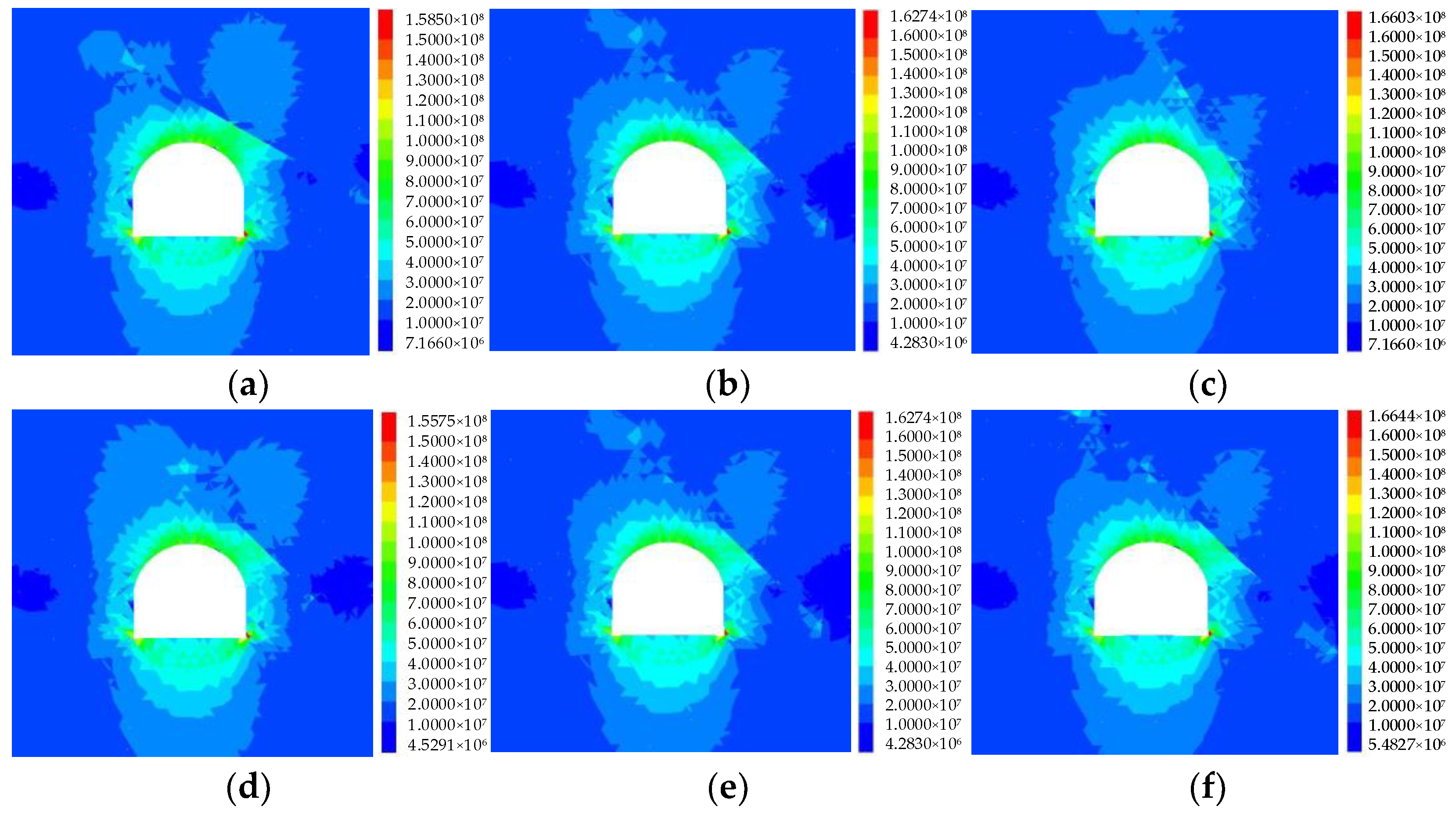

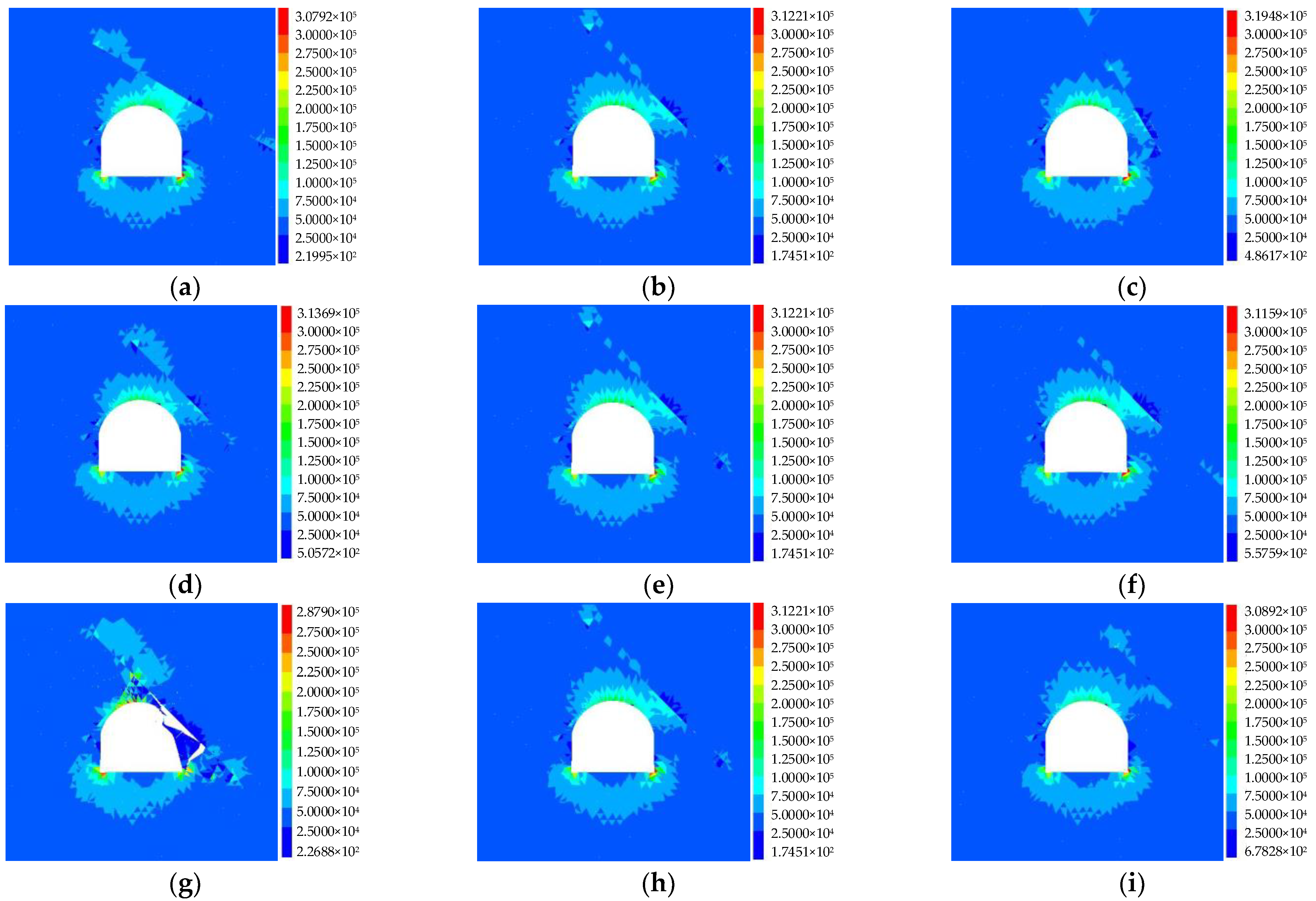

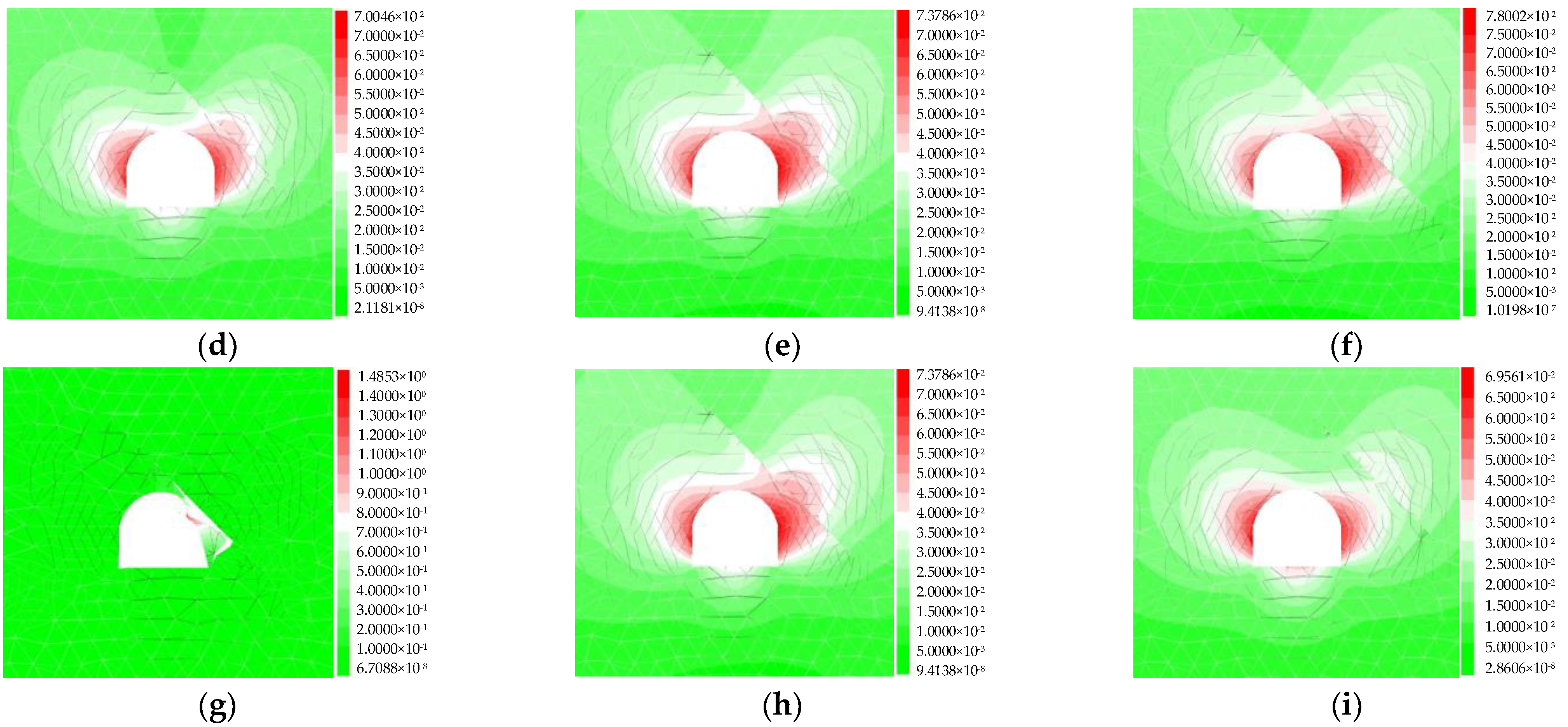
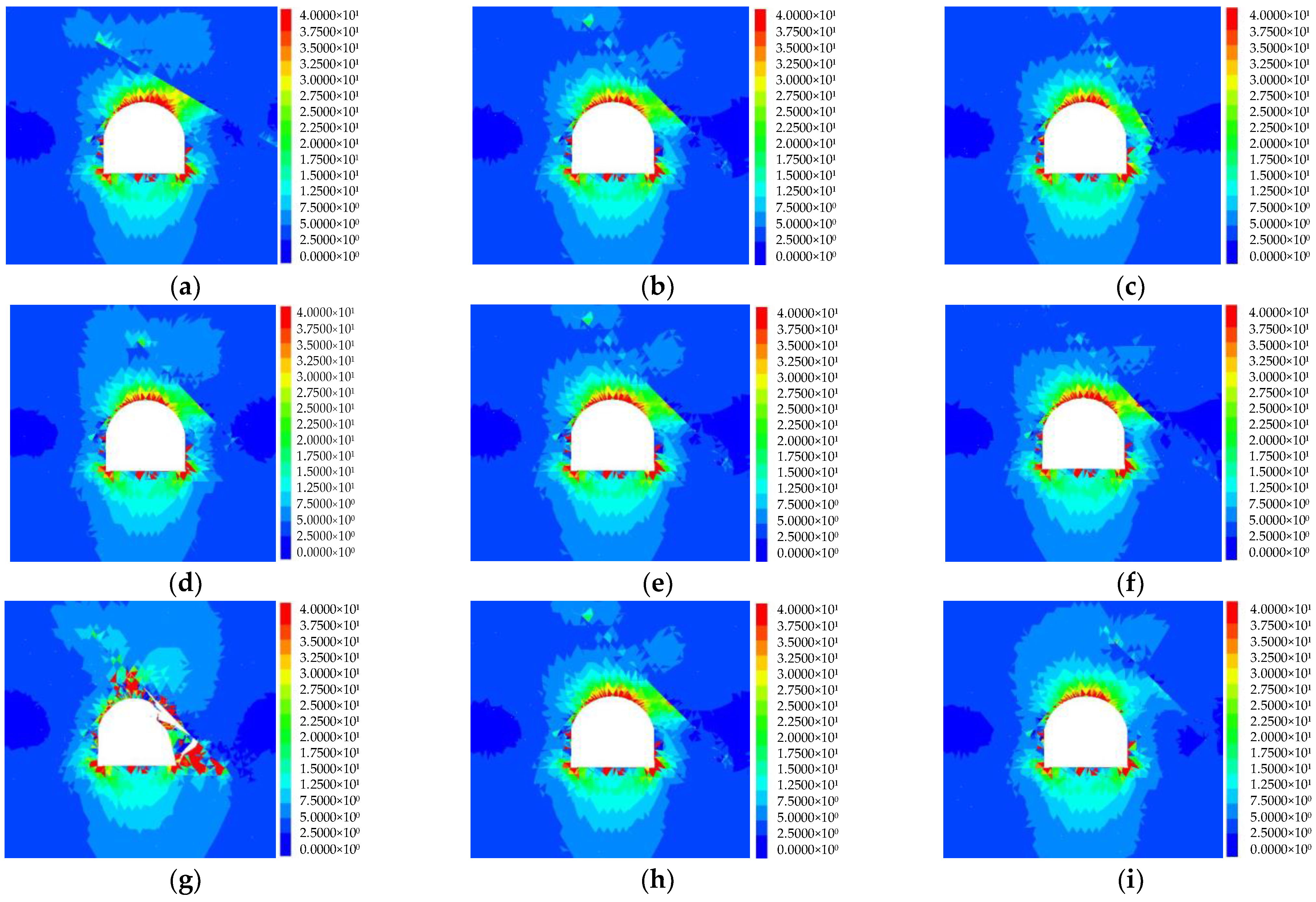




| Crs | <19.0 | 19.0~28.0 | 28.0~40.0 | >40.0 |
|---|---|---|---|---|
| Rockburst intensity | No rockburst | Weak rockburst | Moderate rockburst | Intense rockburst |
| Elastic Modulus (GPa) | Bulk Modulus (GPa) | Shear Modulus (GPa) | Internal Friction Angle (°) | Cohesion Force (MPa) | Tensile Strength (MPa) |
|---|---|---|---|---|---|
| 33.57 | 20.72 | 13.64 | 53.51 | 24.67 | 7.17 |
| Contact Properties | Normal Stiffness (GPa/m) | Shear Stiffness (GPa/m) | Internal Friction Angle (°) | Cohesion Force (MPa) |
|---|---|---|---|---|
| Fictitious joint | 70.45 | 52.20 | 53.51 | 24.67 |
| Structural plane | 10 | 10 | 30 | 1 |
| Condition | Geometric Parameters of Structural Plane | ||
|---|---|---|---|
| Dip Angle (θ) | Length (L) | Relative Distance (D) | |
| a | 30 | 8.5 | 1.7 |
| b | 45 | 8.5 | 1.7 |
| c | 60 | 8.5 | 1.7 |
| d | 45 | 6.5 | 1.7 |
| e | 45 | 8.5 | 1.7 |
| f | 45 | 10 | 1.7 |
| g | 45 | 8.5 | 0 |
| h | 45 | 8.5 | 1.7 |
| i | 45 | 8.5 | 3.4 |
| Density (kg/m3) | Shear Modulus (GPa) | Bulk Modulus (GPa) | Poisson Ratio | Elastic Modulus (GPa) | Cohesion Force (MPa) | Internal Friction angle (°) | Tensile Strength (MPa) |
|---|---|---|---|---|---|---|---|
| 2780 | 7.68 | 11.66 | 0.23 | 18.90 | 15.60 | 25.80 | 6.50 |
| σx/MPa | σy/MPa | σz/MPa | τxy/MPa | τyz/MPa | τxz/MPa |
|---|---|---|---|---|---|
| −46.42 | −51.68 | −61.48 | −2.37 | −0.64 | 3.45 |
Disclaimer/Publisher’s Note: The statements, opinions and data contained in all publications are solely those of the individual author(s) and contributor(s) and not of MDPI and/or the editor(s). MDPI and/or the editor(s) disclaim responsibility for any injury to people or property resulting from any ideas, methods, instructions or products referred to in the content. |
© 2023 by the authors. Licensee MDPI, Basel, Switzerland. This article is an open access article distributed under the terms and conditions of the Creative Commons Attribution (CC BY) license (https://creativecommons.org/licenses/by/4.0/).
Share and Cite
Guo, J.; Zhu, Z.; Zhang, H.; Sun, F.; He, B. Study on Catastrophe Information Characteristics of Strain-Structural Plane Slip Rockburst in Deep Tunnels. Appl. Sci. 2023, 13, 12396. https://doi.org/10.3390/app132212396
Guo J, Zhu Z, Zhang H, Sun F, He B. Study on Catastrophe Information Characteristics of Strain-Structural Plane Slip Rockburst in Deep Tunnels. Applied Sciences. 2023; 13(22):12396. https://doi.org/10.3390/app132212396
Chicago/Turabian StyleGuo, Jiaqi, Zihui Zhu, Hengyuan Zhang, Feiyue Sun, and Benguo He. 2023. "Study on Catastrophe Information Characteristics of Strain-Structural Plane Slip Rockburst in Deep Tunnels" Applied Sciences 13, no. 22: 12396. https://doi.org/10.3390/app132212396
APA StyleGuo, J., Zhu, Z., Zhang, H., Sun, F., & He, B. (2023). Study on Catastrophe Information Characteristics of Strain-Structural Plane Slip Rockburst in Deep Tunnels. Applied Sciences, 13(22), 12396. https://doi.org/10.3390/app132212396







